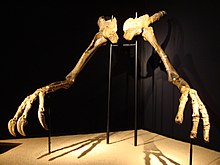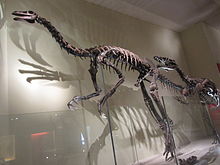Deinocheirus
| Deinocheirus | ||||||||||||
|---|---|---|---|---|---|---|---|---|---|---|---|---|
![Live reconstruction of deinocheirus based on Yuong-Nam Lee et al. (2014). [1] [An 1]](https://upload.wikimedia.org/wikipedia/commons/thumb/5/51/Hypothetical_Deinocheirus.jpg/300px-Hypothetical_Deinocheirus.jpg)
Live reconstruction of deinocheirus based on Yuong-Nam Lee et al. (2014). |
||||||||||||
| Temporal occurrence | ||||||||||||
| Lower Maastrichtian ( Upper Cretaceous ) | ||||||||||||
| 72 to 69.9 million years | ||||||||||||
| Locations | ||||||||||||
| Systematics | ||||||||||||
|
||||||||||||
| Scientific name | ||||||||||||
| Deinocheirus | ||||||||||||
| Osmólska & Roniewicz , 1970 | ||||||||||||
Deinocheirus is a genus of dinosaurs from the Theropoda group , of which only two huge forelimbs, the shoulder girdle and a few other bones were known for a long time, which were discovered by a Polish-Mongolian expedition in 1965 and described in 1970. The fossil remains of Deinocheirus were discovered in the Nemegt formation in the Mongolian province of Ömnö-Gobi-Aimag and first described in 1970 by the paleontologists Halszka Osmólska and Ewa Roniewicz. The name is derived from the Greek words deinos ('terrible') and cheir ('hand'). The type and only known species is Deinocheirus mirificus .
The finds are dated in the late Upper Cretaceous (Lower Maastrichtian ) to an age of 72 to 69 million years. Replicas of the fossil arms are currently on display at the American Museum of Natural History , New York, the Natural History Museum , London, the Dinosaur Museum in Utah and the Paleontological Museum at the University of Oslo. Other fossils of the genus were found in 2006 and 2009 and described in 2014. With their help, the external appearance of Deinocheirus could be clarified.
features

The forelimbs of the holotype (ZPal MgD-I / 6) are around 2.4 meters long, the humerus alone measures 94 centimeters. The three metacarpal bones are approximately the same length (21 to 24 centimeters), the three fingers have large, curved claws that are pointed at the front. The arms show some similarities with the Ornithomimosauria , such as the roughly equal length of the metacarpal bones or the smaller deltopectoral crest on the upper arm. In contrast to these dinosaurs, the ulna and radius are not compressed and the shoulder blade is also different.
The other finds from the 2000s are much more complete. The specimen with catalog number MPC-D 100/127 is an almost complete skeleton. Only the right forearm, the middle dorsal vertebrae and numerous tail vertebrae are missing. MPC-D100 / 128 consists of parts of the spine (the cervical vertebrae are lacking), parts of the basin (the ilium (ilium) and a partially preserved ischial (ischium)) and the left hind leg. They show that Deinocheirus reached a length of eleven meters, a standing height of four meters and a weight of over six tons. He was thus the largest and heaviest known representative of the ornithomimosaurids. The mouth was toothless and the snout, which is unusually long for ornithomimosaurids, was long and wide. The snout was curved downwards in front and, when viewed from above, widened like a duck's bill, similar to that of the unrelated hadrosaurs . The tip of the snout probably had a horned beak in the living animal. The lower jaw was much higher than the upper jaw and could have provided space for a massive tongue. Since the attachment points of the jaw muscles were relatively small for such a large skull, the bite force of Deinocheirus was rather low. The ten cervical vertebrae were long and flattened. Towards the rear they become increasingly shorter and more trapezoidal . As a result, the neck of the living animal was bent in an S-shape. The dorsal vertebrae had long spinous processes and, similar to the Spinosaurus and Ouranosaurus , supported a dorsal sail or a hump like a camel. The largest spinous processes were 8.5 times higher than the vertebral body. A complicated system of ligaments between the spinous processes was probably used to support the heavy body like a cable-stayed bridge . The pelvis was hypertrophied for the same reason . The ischium and pubis were of equal length. The hind legs were relatively short and had shortened toes, the tips of which were widened like a hoof. The thigh bone was longer than the shin. As in birds, the collarbones were fused into a U-shaped bone, the fork bone (furcula). All vertebrae with the exception of the atlas and the last caudal vertebrae and the spinous processes of the six sacral vertebrae were pneumatized (hollow and filled with air). The tail ended in a pygostyle formed from two fused vertebrae, possibly with tail feathers, similar to that of the therizino and oviraptorosaurids . Pygostyle and furcula were previously unknown in ornithomimosaurids. The size and possibly the color of the dorsal sail and the tail feathers could have served the communication with conspecifics (intraspecific communication) and the display behavior .
Way of life
More than 1400 gastroliths (⌀ 8 to 87 mm) and bones and scales of fish were found in the abdominal area of MPC-D 100/127 . The long front limbs with the strong claws could also have been used for digging up and gathering plants. Thus, Deinocheirus was an omnivore that lived in a moist environment characterized by meandering river arms. The short hind legs show that it was relatively slow to move and that it was clumsy. The broad feet prevented it from sinking into the damp ground. The gigantism of Deinocheirus may have provided some protection from carnivores like Tarbosaurus . However, fragmented single bones and gastralia, which are assigned to the holotype specimen, have bite marks that probably come from Tarbosaurus .
Systematics
As already suspected by the authors of the first description, Deinocheirus belongs to the Ornithomimosauria , the "bird imitation lizards", which are often compared to ratites and are also called "ostrich dinosaurs". Together with its sister genus Garudimimus and Beishanlong , both also from Asia, Deinocheirus forms the family Deinocheiridae, which is the sister group of the Ornithomimidae .
The following cladogram shows the systematic position of Deinocheirus within the Ornithomimosauria.
| Ornithomimosauria |
|
||||||||||||||||||||||||||||||||||||||||||
|
|
annotation
- ↑ The full fletching in this reconstruction drawing is speculative. So far there are only signs of down-like fletching within the Ornithomimosauria in Ornithomimus . In the work by Yuong-Nam Lee and colleagues, a reconstruction drawing is shown in which the deinocheirus is only feathered on the undersides of the arms, on the head and on the end of the tail. But that too is speculative.
Individual evidence
- ↑ a b c d e f g Yuong-Nam Lee, Rinchen Barsbold , Philip J. Currie , Yoshitsugu Kobayashi, Hang-Jae Lee, Pascal Godefroit, François Escuillié and Tsogtbaatar Chinzorig. 2014. Resolving the Long-standing Enigmas of A Giant Oornithomimosaur Deinocheirus mirificus. Nature . October 2014, doi: 10.1038 / nature13874
- ↑ Halszka Osmólska, Ewa Roniewicz: Deinocheiridae, a new family of theropod dinosaurs. In: Palaeontologia Polonica. Vol. 21, 1970, ISSN 0078-8562 , pp. 5-19, digital version (PDF; 1.5 MB)
- ↑ Peter J. Makovicky , Yoshitsugu Kobayashi, Philip J. Currie : Ornithomimosauria. In: David B. Weishampel , Peter Dodson , Halszka Osmólska (eds.): The Dinosauria . 2nd edition. University of California Press, Berkeley CA et al. 2004, ISBN 0-520-24209-2 , pp. 137-150.
- ↑ Bell, PR; Currie, Philip J .; Lee, Yuong-Nam (2012). Tyrannosaur feeding traces on Deinocheirus (Theropoda:? Ornithomimosauria) remains from the Nemegt Formation (Late Cretaceous), Mongolia. Cretaceous Research 37 (2012): 186-190. doi: 10.1016 / j.cretres.2012.03.018

